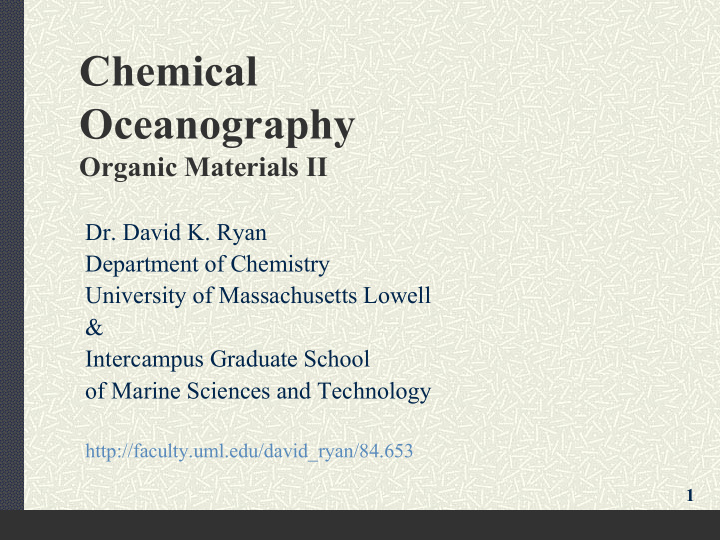



Chemical Oceanography Organic Materials II Dr. David K. Ryan Department of Chemistry University of Massachusetts Lowell & Intercampus Graduate School of Marine Sciences and Technology http://faculty.uml.edu/david_ryan/84.653 1
Organic Compounds in Marine Environment Where do they come from? What are they? POC Why are they important? Detritus Where do they go? Fecal Mat. DOC Biological molecules (lipids, proteins, carbohydrates, etc., etc.) Hydrocarbons Humic Materials (=other stuff) 2
What is this stuff? Morel, 1983 3
4 Emerson & Hedges 2010 Flame Ionization (FI), Fluorescence (Flu), Pulsed Amperometric (PA) Mass Spectrometry (MS), UV absorption
All Dissolved Organic Compounds OC DOC Dissolved Carbon NOC Organic OM Matter Natural NOM DOM Humic Subset Materials HM Humic Substances HS CDOM Humic Acid HA Fulvic Acid FA Ryan & Chromophoric Zhu 2013 or Colored DOM
Libes, 1992 20 6
Humic Materials Complex natural organic molecules Properties & importance understood Some structural components known Exact chemical nature or exact structure unknown because: Deficiencies in analytical Complexity Heterogeneity techniques Interfering species Concentrations 7
Organic Carbon Continuum Libes, 1992 8
um) Millero, 2007 9
Carbon Cycle Libes, 1992 Inventories in 10 15 g C = BMT Fluxes (arrows) 10 15 g C/yr 10
Distribution of Organic Carbon (a) Major compartments in the global ocean (b) Major compartments for the planet Cauwet, 1978 11
12
Active Carbon Reservoirs (excluding Ocean DIC) Surf. Ocean Seds. Ocean DOC 3% Soil IC 12% 22% Terr. Plants 19% Atm. CO2 13% Soil OC 32% 13
Organic Compounds in Marine Environment Where do they come from? What are they? Hydrocarbons Bio & Geo Carbohydrates (polysaccharides), sugars Lipids, fats, waxes, oils, fatty acids Pigments Bio Nucleic acids, RNA, DNA Amino acids, polypeptides, proteins, enzymes Low molecular weight carboxylic acids ? Humic Substances 14
ers 15
16
Organic Compounds in Marine Environment Where do they come from? What are they? Hydrocarbons Bio & Geo Carbohydrates (polysaccharides), sugars Lipids, fats, waxes, oils, fatty acids Pigments Bio Nucleic acids, RNA, DNA Amino acids, polypeptides, proteins, enzymes Low molecular weight carboxylic acids ? Humic Substances 17
Organic Carbon Inputs to the Ocean Allochthonous = formed externally ( ex situ ) Autochthonous = formed internally ( in situ ) Most Marine Humic Material is formed in situ through both biotic & abiotic processes Some Humic Material (i.e., coastal) is introduced from terrestrial sources (formed on land) 18
Transformation of DOC Biological molecules are labile = readily broken down or degraded quickly By-products of this breakdown (substances not completely remineralized) can react with other organic compounds in a process called Humification or Early Diagenesis This results in non-labile Humic Materials Humics may degrade slowly or be removed to the sediments ( refractory or non-labile ) 19
Transformation of DOC These processes occur in the water column, in sediments, & in soils Humification is the first step, fast, aerobic Fossilization or carbonification occur more slowly on geologic time scales, anaerobicly, after burial in sediments Diagenesis, Catagenesis, Metagenesis 20
Biotic Hydrocarbons, Fats, Waxes Oils, Sterols, Vitamins, etc. Humification of Organic Matter Abiotic (possible scheme) aggregation agglomeration Libes, 1992 21 Macromoloecules
Humification of Organic Matter (another scheme) Libes, 1992 22
Emerson & Hedges Figure 8.2 23
Morel & Hering, 1993 See also Emerson & Hedges Figure 8.11 & 8.12 24
Humic Structure Proposed by Schnitzer (Rashid 1985) 25
Structure Attributed to Gamble et al. (1985) 26
Morel & Hering (1993) Based on Aiken et al. (1985) 27
Possible Structural Units Set Forth by Averett, Leenheer, McKnight & Thorn (1989) From Morel & Hering, 1993 28
Kleinhempel reprinted from Albrecht Thaer Archiv (1970) 29
Organic Solute Macromolecule (ORSMAC) Leenheer 1985) 30
Molecular model of the lowest energy conformation of humic acid building blocks Carbon atoms-green Oxygen atoms-red Nitrogen-blue Davies & Ghabbour, 1999 Hydrogen not shown 31
Importance of Humic Materials Global Carbon Reservoir Take Part in Interfacial Phenomena Undergo Coagulation and Aggregation Involved in Photochemical Reactions Contain Radicals Known Reducing Agents Methylate Metals Form Chlorinated Species, THMs DBPs Detoxify Metals Limit Bioavailability of Metals Alter Solubility Influence Bind Metals & Organic Pollutants Terminal Electron Transport Acceptor for Bacteria
33
Fox, 1983 34
Photochemistry CDOM = Chomophoric (Colored) Organic Matter 35
Metal Complexation by Humic Materials Leenheer et al. (1998) Morel (1983) 36
References Cauwet, G. (1978) Oceanologica Acta 1, 99 Davies & Ghabbour (1999) Chemistry & Industry 7, 426 Fox, L. (1983) Estuarine Coastal Shelf Sci. 16, 431 Hedges, J.I. (1992) Global Biogeochemical Cycles: Progress and Problems, Mar. Chem. 39, 67 Leenheer, J.A. (1985) in Humic Substances in Soil Sediment and Water: Geochemistry, Isolation and Characterization, Wiley, NY, pp. 409-429 Lenheer, J.A. et al. (1998) Environ. Sci. Technol. 32, 2410 Rashid, M.A. (1985) Geochemistry of Marine Humic Compounds, Springer-Verlag, NY, NY, 300 pages 37
Chemical Oceanography Organics III Dr. David K. Ryan Department of Chemistry University of Massachusetts Lowell & Intercampus Graduate School of Marine Sciences and Technology http://faculty.uml.edu/David_Ryan/84.653 38
Sea Foam caused by naturally occuring surface active agents 39
40
Air-Sea Interfacial Chemistry Surface active compounds concentrated at interface 41
Morel & Hering, 1993 42
Importance of Humic Materials Global Carbon Reservoir Take Part in Interfacial Phenomena Undergo Coagulation and Aggregation Involved in Photochemical Reactions Contain Radicals Known Reducing Agents Methylate Metals Form Chlorinated Species, THMs DBPs Detoxify Metals Limit Bioavailability of Metals Alter Solubility Influence Bind Metals & Organic Pollutants Terminal Electron Transport Acceptor for Bacteria 43
44
Fox, 1983 45
Millero, 1996 46
Photochemistry CDOM = Chomophoric (or Colored) Dissolved Organic Matter 47
Quinone radical present in humic material Scott, McKnight, Blunt-Harris, Kolesar & Lovely (1998) Environ. Sci. Technol. 32, 19 48
49
Recommend
More recommend